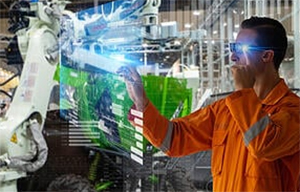
14 June 2021 | ESCATEC Mechatronics Ltd
What are the top digital trends for electronics manufacturing?
With artificial intelligence (AI) already a firm fixture in our smartphones, fitness trackers and smart assistants, it was really only a matter of time before we would start to see digital tools and technologies finding their way into the UK electronics manufacturing environment.
The concept of digital transformation is nothing especially new for business, but bringing these ideas to reality has not always been an easy task.Over the past year though, the events of COVID-19 have forced many manufacturers to rethink how they can shore up their supply chains, make more effective real-time decisions and deliver an even better customer experience.
So what digital innovations look set to be firm fixtures in the factories of the future?
Predictive maintenance
While breakdowns of critical equipment are normal occurrences in the manufacturing industry, the effects can be hugely costly to manufacturers in terms of unplanned downtimes, additional repair costs and loss of productivity.
By harnessing the power of predictive analytics tools, key data can be collected from a machine and compared against its usual pattern of operation.
Even the tiniest of changes or inconsistencies can be instantly detected so manufacturers can better understand how their systems work, how they may fail and when this is likely to happen.
And because predictive testing can also be conducted even while equipment is operational, the costs, and the consequences, of planned and unplanned downtime are massively reduced.
Additive manufacturing
3D printing has been a staple in additive manufacturing for almost four decades, so it was really only a matter of time before we would start to see the printed circuit board (PCB) and integrated circuit (IC) industries capitalising on the use of 3D printers to create “smart parts” with embedded electronics.
By integrating additive manufacturing machines within the electronics manufacturing environment, there is the ability to produce a vast array of high-end electronics all of which can be created within a single, seamless process.
US-based company Nano Dimension has already demonstrated the potential of additively manufactured electronics (AME) by using their lights-out digital manufacturing DragonFly 3D printers to print a range of next-generation PCBs.
While conventionally-produced PCBs normally require the use of a pick and place machine in order to embed certain components, 3D technology makes it possible to print up to fifty alternating layers on a single circuit.
These circuits can also be stacked and interconnected in a myriad of ways which increases component density and makes it possible to work on three dimensional surfaces. Using 3D, through-holes can also be printed in any orientation and the need for drilling, etching and electroplating is eliminated.
Digital simulation
The use of simulations, virtual reality and augmented reality offer some exciting benefits for the electronics manufacturing environment - from developing prototypes to aiding in assembly maintenance and enabling operators to visualise workflows before they adjust their production lines.
Even as far back as 2015, 3D glasses were being used as standard equipment by Volkswagen to help their logistics workers facilitate order picking.
By 2019 the company had invested in cutting-edge 3D holography which enables them to project displays three-dimensionally without the need for 3D glasses.
Digital twin technology also looks set to offer manufacturers a new level of resilience and flexibility by enabling them to create virtual versions of their products and to simulate how they will perform in the real world.
The synergy of human and machine
Much has been written about the ways in which Industry 4.0 has revolutionised the manufacturing environment, with robotics, 5G connectivity and the use of data from smart devices enabling manufacturers to connect, predict and adapt their products with even greater efficiency.
Equally though, there is also increasing recognition of the value of the “human factor” in delivering unique, memorable and sustainable customer experiences.
In 2018, the Genpact manufacturing report “Manufacturing in the Age of Instinct” predicted that the coming decade would be marked by manufacturers’ embracing servitisation, with the emphasis shifting to finding new ways to create better value for customers.
While the electronics manufacturing landscape continues to be reshaped by the power of digital technologies, big data and the Internet of Things, there is also growing interest in finding ways for humans and smart devices to work together.
With the advent of Industry 5.0, we are now beginning to see the merging of the best attributes of humans and machines - combining human insight and AI techniques to improve the manufacturing process.
Charting the uptake of digital technologies
At the start of 2020 the World Economic Forum reported that more than 70% of industrial companies were still only at the start of their digital journey, with many still struggling to create the momentum that they needed to move beyond the pilot stage.
Less than twelve months later, a poll of several hundred US manufacturers in November 2020 found that more than three-quarters expected their companies to increase investment in digital technologies in the year ahead.
Now as we reach the mid-way mark of 2021, an industry report from Accenture reveals that 77% of company executives believe their technology architecture is “critical to the overall success of their organisation.”
As the events of the global pandemic of the last twelve months have proven, agility, responsiveness and resiliency are absolutely key in an environment of disruption.
Perhaps now more than ever, the new digital age offers a way for electronics manufacturers to re envision the way they do business - from streamlining their production processes, to improving the quality of their products and delivering an even better customer experience.